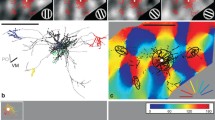Abstract
The vertebrate nervous system has topographic interconnections in many parts, known for example as retinotopy, somatotopy, etc. It is plausible that modifiable synapses play an important role in forming and refining these connections together with the sensory experiences. To elucidate the mechanism of topographic organization, we propose a simple model consisting of two nerve fields connected by modifiable excitatory synapses. The model also includes modifiable inhibitory synapses. The behavior of the model is described by a set of simultaneous non-linear integro-differential equations. By analyzing the equations, we obtain the equilibrium solution of topographic connections. It is also proved that a part of the presynaptic field which is frequently stimulated comes to be mapped on a large area of the postsynaptic field so that it has a good resolution.
Similar content being viewed by others
Literature
Arbib, M. A. 1972.The Metaphorical Brain. New York: Wiley.
Amari, S. 1972. “Characteristics of Random Nets of Analog Neuron-like Elements.”IEEE Trans., Systems, Man and Cybernetics.SMC-2, 643–657.
— 1974. “A Method of Statistical Neurodynamics.”Kybernetik 14, 201–215.
— 1977a. “Dynamics of Pattern Formation in Lateral-inhibition Type Neural Fields.”Biol. Cybernet. 27, 77–87.
— 1977b. “Neutral Theory of Association and Concept-formation.”Biol. Cybernet. 26, 175–185.
—, and Arbib, M. A. 1977. “Competition and Cooperation in Neural Nets.”Systems Neuroscience Ed. J. Metzler, 119–165. New York: Academic Press.
—, and Takeuchi, A. 1978. “Mathematical Theory on Formation of Category Detecting Nerve Cells.”Biol. Cybernet. 29, 127–136.
—, Yoshida, K. and Kanatani, K. 1977. “A Mathematical Foundation for Statistical Neurodynamics.”SIAM J. Appl. Math. 33, 95–126.
Gaze, R. M. 1970.The Formation of Nerve Connections. London: Academic Press.
—, Jacobson, M. and Szekely, G. 1965. “On the Formation of Connections by Compound Eyes inXenopus”.J. Physiol. 176, 409–417.
— and Keating, M. J. 1972. “The Visual System and ‘Neuronal Specificity’.”Nature, Lond. 237, 375–378.
Geman, S. 1979. “Some Averaging and Stability Results for Random Differential Equations.”SIAM J. Appl. Math. 36, 86–105.
Hope, R. A., Hammond, B. J. and Gaze, R. M. 1976. “The Arrow Model—Retinotectal Specificity and Map Formation in the Goldfish Visual System.”Proc. R. Soc. B 194, 447–466.
Kishimoto, K. and Amari, S. 1979. “Existence and Stability of Local Excitations in Neural Fields.”J. Math. Biol. 7, 303–318.
Kohonen, T. and Oja, E. 1976. “Fast Adaptive Formation of Orthogonalizing Filters and Associative Memory in Recurrent Networks of Neuron-like Elements.”Biol. Cybernet. 21, 85–95.
Malsburg, C. von der. 1973. “Self-organization of Orientation Sensitive Cells in the Striate Cortex.”Kybernetik 14, 85–100.
Prestige, M. C. and Willshaw, D. J. 1975. “On a Role for Competition in the Formation of Patterned Neural Connections.”Proc. R. Soc. B 190, 77–98.
Sharma, S. C. 1972. “Reformation of Retinotectal Connections after Various Tectal Ablations in Adult Goldfish.”Exp. Neurol. 34, 171–182.
Sperry, R. W. 1951. “Mechanism of Neural Maturation.”Handbook of Experimental Psychology, Ed. S. S. Steven, pp. 236–280. New York: Wiley.
Takeuchi, A. and Amari, S. “Formation of Topographic Maps and Columnar Microstructures in Nerve Fields.”Biol. Cybernet. (in press).
Willshaw, D. J. and Malsburg, C. von der. 1976. “How Patterned Neural Connections can be Set up by Self Organization.”Proc. R. Soc. B 194, 431–445.
Wilson, H. R. 1975. “A Synaptic Model for Spatial Frequency Adaptation.”J. Theoret. Biol. 50, 327–352.
Yoon, M. 1971. “Reorganization of Retinotectal Projection Following Surgical Operations on the Optic Tectum in Goldfish.”Expl. Neurol. 33, 395–411.
—, 1972. “Transposition of the Visual Projection from the Nasal Hemi-retina onto the Foreign Rostral Zone of the Optic Tectum in Goldfish.”Expl. Neurol. 37, 451–462.
Zeeman, C. 1962. “The topology of the Brain and Visual Perception.”Topology of 3-Manifolds and Related Topics, Ed. M. K. Fort, pp. 240–256, Englewood Cliffs: Prentice-Hall.
Author information
Authors and Affiliations
Rights and permissions
About this article
Cite this article
Amari, SI. Topographic organization of nerve fields. Bltn Mathcal Biology 42, 339–364 (1980). https://doi.org/10.1007/BF02460791
Received:
Revised:
Issue Date:
DOI: https://doi.org/10.1007/BF02460791




